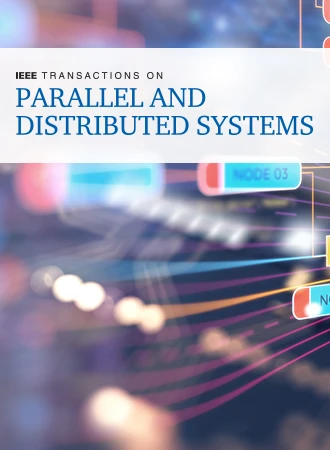The Megapixel Approach for Efficient Execution of Irregular Wavefront Algorithms on GPUs
IF 6
2区 计算机科学
Q1 COMPUTER SCIENCE, THEORY & METHODS
IEEE Transactions on Parallel and Distributed Systems
Pub Date : 2025-09-23
DOI:10.1109/TPDS.2025.3612696
引用次数: 0
Abstract
Morphological operations are critical in high-resolution biomedical image processing. Their efficient execution relies on an irregular flood-filling strategy consolidated in the Irregular Wavefront Propagation Pattern (IWPP). IWPP was designed for GPUs and achieved significant gains compared to previous work. Here, however, we have revisited IWPP to identify the key limitations of its GPU implementation and proposed a novel more efficient strategy. In particular, the IWPP most demanding phase consists of tracking active pixels, those contributing to the output, that are the ones processed during the execution. This computational strategy leads to irregular memory access, divergent execution, and high storage (queue) management costs. To address these aspects, we have proposed the novel execution strategy called Irregular Wavefront Megapixel Propagation Pattern (IWMPP). IWMPP introduces a coarse-grained execution approach based on fixed-size square regions (instead of pixels in IWPP), referred to as megapixels (MPs). This design reduces the number of elements tracked and enables a regular processing within MPs that, in turn, improves thread divergence and memory accesses. IWMPP introduces optimizations, such as Duplicate Megapixel Removal (DMR) to avoid MPs recomputation and Tiled-Ordered (TO) execution that enforces a semistructured MPs execution sequence to improve data propagation efficiency. Experimental results using large tissue cancer images demonstrated that the IWMPP GPU attains significant gains over the state-of-the-art (IWPP). For morphological reconstruction, fill holes, and h-maxima operations, on the RTX 4090, the IWMPP GPU is up to 17.9×, 45.6×, and 14.9× faster than IWPP GPU, respectively, while at the same time reducing memory demands. IWMPP is an important step to enable quick processing of large imaging datasets.在gpu上高效执行不规则波前算法的百万像素方法
形态学操作是高分辨率生物医学图像处理的关键。它们的有效执行依赖于不规则波前传播模式(IWPP)中巩固的不规则洪水填充策略。IWPP是为gpu设计的,与以前的工作相比取得了显著的进步。然而,在这里,我们重新审视了IWPP,以确定其GPU实现的关键限制,并提出了一种新的更有效的策略。特别是,IWPP要求最高的阶段包括跟踪活动像素,这些像素对输出有贡献,是在执行期间处理的像素。这种计算策略导致不规则的内存访问、分散的执行和高存储(队列)管理成本。为了解决这些问题,我们提出了一种新的执行策略,称为不规则波前百万像素传播模式(IWMPP)。IWMPP引入了一种基于固定大小的正方形区域(而不是IWPP中的像素)的粗粒度执行方法,称为百万像素(MPs)。这种设计减少了跟踪元素的数量,并使MPs内的常规处理成为可能,这反过来又改善了线程发散和内存访问。IWMPP引入了优化,例如重复百万像素移除(Duplicate Megapixel Removal, DMR)以避免MPs的重新计算和平排顺序(tile - ordered, to)执行,后者强制执行半结构化的MPs执行序列,以提高数据传播效率。使用大型组织癌图像的实验结果表明,IWMPP GPU比最先进的(IWPP)获得了显著的收益。在RTX 4090上,IWMPP GPU的形态学重构、补孔和h-maxima运算速度分别比IWPP GPU快17.9倍、45.6倍和14.9倍,同时降低了对内存的需求。IWMPP是实现大型成像数据集快速处理的重要步骤。
本文章由计算机程序翻译,如有差异,请以英文原文为准。
求助全文
约1分钟内获得全文
求助全文
来源期刊

IEEE Transactions on Parallel and Distributed Systems
工程技术-工程:电子与电气
CiteScore
11.00
自引率
9.40%
发文量
281
审稿时长
5.6 months
期刊介绍:
IEEE Transactions on Parallel and Distributed Systems (TPDS) is published monthly. It publishes a range of papers, comments on previously published papers, and survey articles that deal with the parallel and distributed systems research areas of current importance to our readers. Particular areas of interest include, but are not limited to:
a) Parallel and distributed algorithms, focusing on topics such as: models of computation; numerical, combinatorial, and data-intensive parallel algorithms, scalability of algorithms and data structures for parallel and distributed systems, communication and synchronization protocols, network algorithms, scheduling, and load balancing.
b) Applications of parallel and distributed computing, including computational and data-enabled science and engineering, big data applications, parallel crowd sourcing, large-scale social network analysis, management of big data, cloud and grid computing, scientific and biomedical applications, mobile computing, and cyber-physical systems.
c) Parallel and distributed architectures, including architectures for instruction-level and thread-level parallelism; design, analysis, implementation, fault resilience and performance measurements of multiple-processor systems; multicore processors, heterogeneous many-core systems; petascale and exascale systems designs; novel big data architectures; special purpose architectures, including graphics processors, signal processors, network processors, media accelerators, and other special purpose processors and accelerators; impact of technology on architecture; network and interconnect architectures; parallel I/O and storage systems; architecture of the memory hierarchy; power-efficient and green computing architectures; dependable architectures; and performance modeling and evaluation.
d) Parallel and distributed software, including parallel and multicore programming languages and compilers, runtime systems, operating systems, Internet computing and web services, resource management including green computing, middleware for grids, clouds, and data centers, libraries, performance modeling and evaluation, parallel programming paradigms, and programming environments and tools.
 求助内容:
求助内容: 应助结果提醒方式:
应助结果提醒方式:


